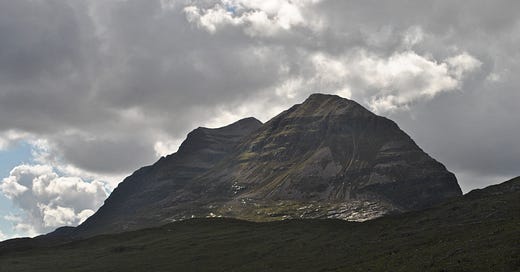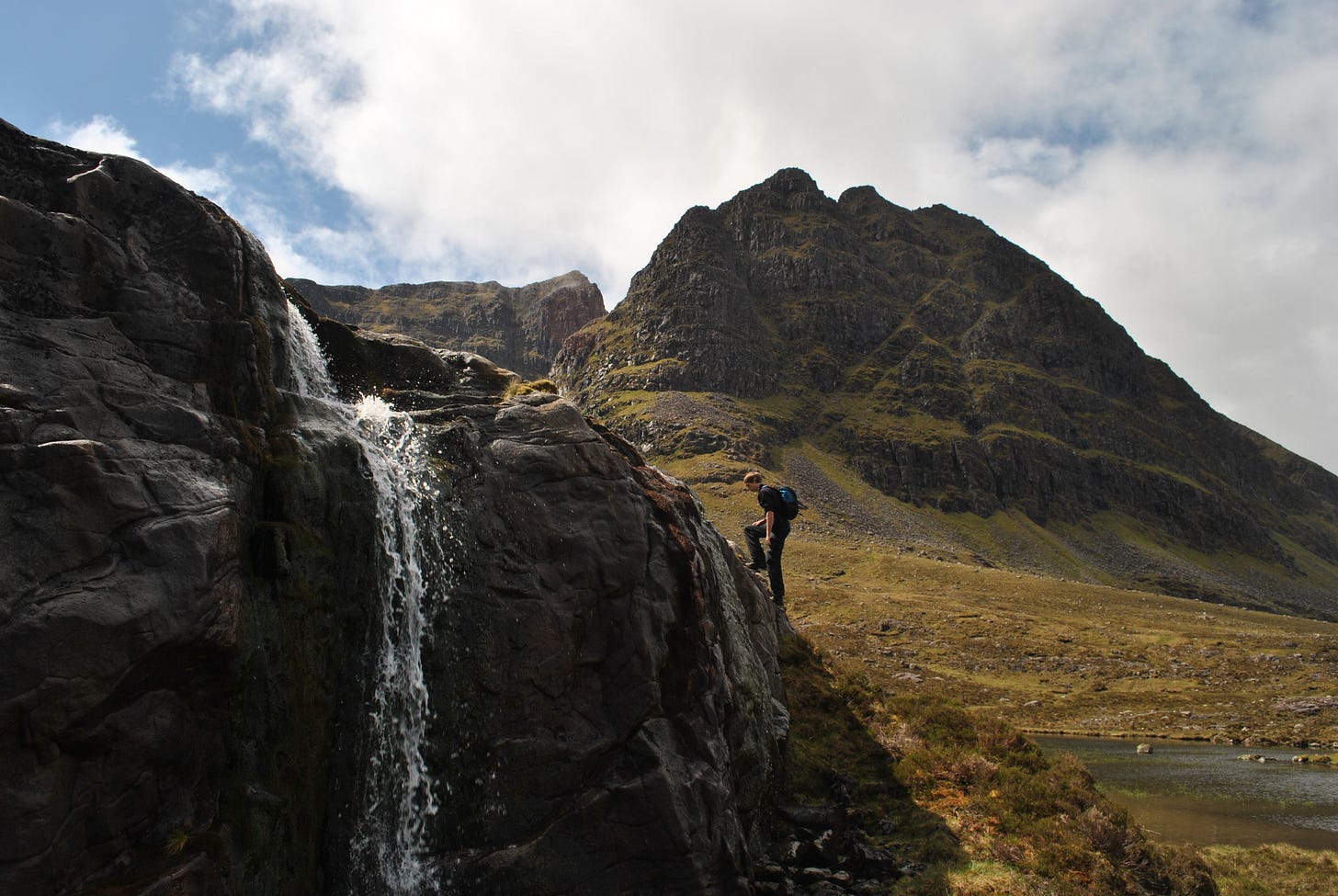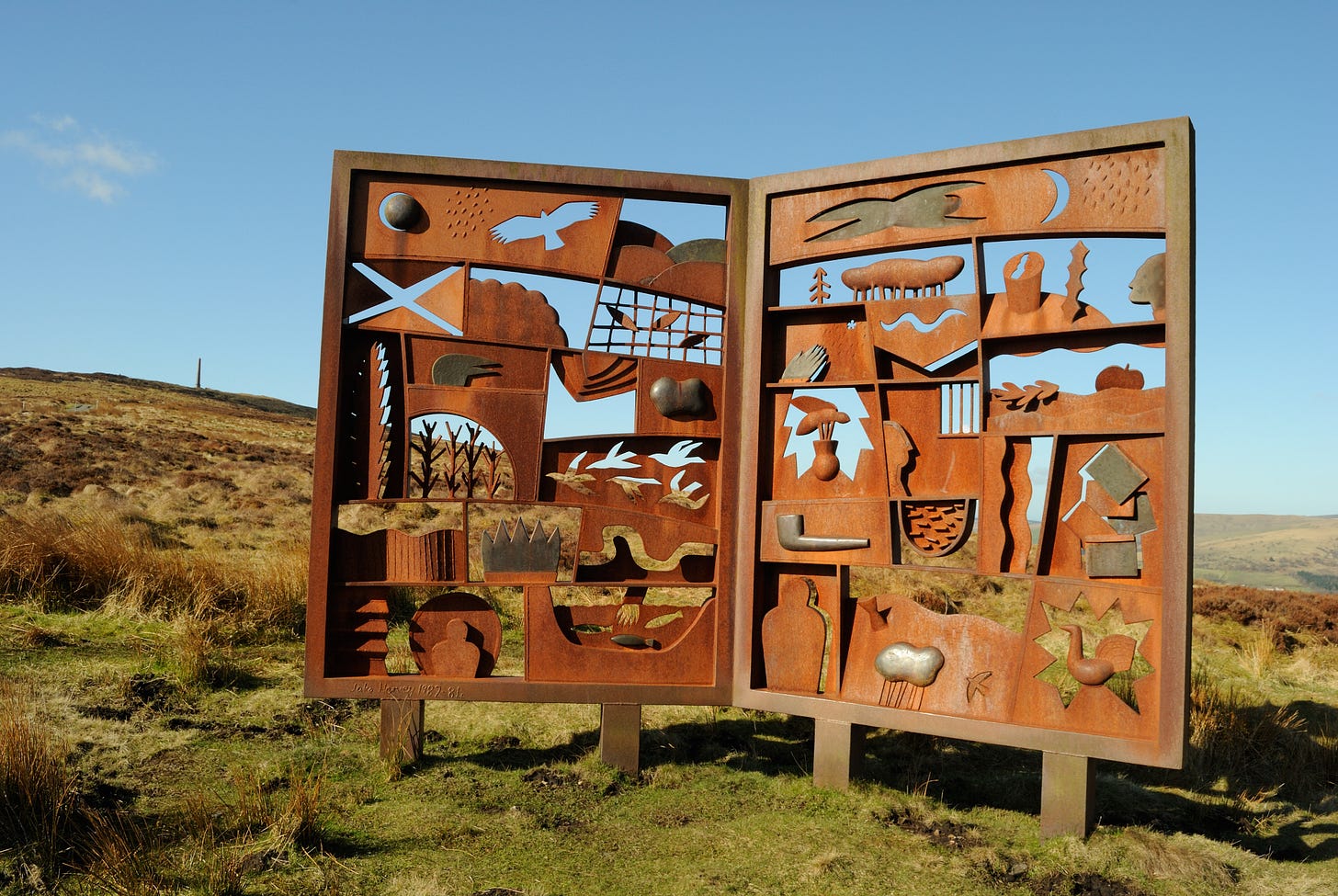Coire na Caime, Liathach
Scotland's poet Hugh MacDiarmid has written about Liathach in a verse that embraces the mountain in all its peculiar sandstone grimness. [900 words, 4 mins
Before Christmas I wrote about TS Eliot’s rather surprising Scottish poem ‘Rannoch by Glencoe’. Reader Jim Benstead passed on a sardonic comment on Eliot from Hugh MacDiarmid’s “A Drunk Man Looks at the Thistle” (1926):
T. S. Eliot — it's a Scottish name —
Afore he wrote " The Waste Land" s'ud ha'e come
To Scotland here. He wad ha'e written
A better poem syne — like this, by gum!1
Is ‘Rannoch by Glencoe’ indeed a better poem? Well, I’ve not read right through the extended poetical/political rant that is ‘Drunk Man’, so I can’t judge on that. But it does make a great lead-in to this week’s post, which is about a great Scottish mountain, and a great poem about it by Hugh MacDiarmid himself.
The massive, layered, sandstone Torridonian mountains rise from the watery moorland of the Lewisian Gneiss. They rise for a thousand metres, in rounded slabs of brownish red which darken to brownish black under the West Highland rain.
These sands were once a wide desert: desert, because, a billion years ago, plantlife had yet to arrive on Earth’s land surface. The Torridonian wilderness endured for hundreds of millions of years: as long a time as from today back to when the first four-limbed fishes crawled ashore and started breathing air. Lakebeds or floodplains, happening every million years or so, have made occasional layers of softer mudstone: these erode away into sloping, heather covered terraces across the mountainside. Moss and slime drain from the terraces, staining the rounded, massive slabs below. And the higher hills, Beinn Eighe and Liathach, are topped off with off-white quartzite that in some lights seems like a capping of snow, though the actual colour is more like old bones.
The North Face of Liathach
Lives in the mind like a vision.
From the deeps of Coire na Caime
Sheer cliffs go up
To spurs and pinnacles and jagged teeth.
Its grandeur draws back the heart.
‘The North Face of Liathach’ 19552
Coire na Caime is the bent or crooked corrie – and like those two English words, 'cam' can also mean bent or crooked in a moral sense, and even 'one-eyed'. Seen from the small single-track road, Liathach rises to a tentlike ridge above Glen Torridon: tier upon tier of the reddish-brown sandstone, with no obvious way up it. But Coire na Caime is out of sight around the back. An old deer-stalkers' path leads in along the gorge of the Mhic Nobuill burn. The path is sometimes a line of rocks across a bog, but more often is pleasantly floored with sand, as the cliffs above it slowly erode back to what they were originally made of.
The path is signposted by the National Trust from the valley road at either end, and is kept in fairly good order. As you pass along it, and supposing the mountain above is free of cloud, your eye is drawn by the line of jagged pinnacles, the famous Fasarinen that form the corrie’s upper rim. With the sun shining over the mountain, the dark, backlit corrie below is less of an eye-catcher. And the inner corner of it is out of sight anyway, tucked behind a second set of pinnacles leading up to Liathach's western summit, the one called Mullach an Rathain.
So you leave the National Trust’s path and cross the valley floor. Among the humps left by the glacier there has to be a small river somewhere but it's still a surprise when you find it. Climbing to the lip of the corrie the going gets rockier, undulating slabs of sandstone dotted with glacier boulders and harbouring a hundred shallow pools. Then a rock wall a few metres high is the edge of the next sandstone slab. A stream splashes white down the dark rockface, and a set of little ledges and steps leads up beside the water to a whole lot more rocks and lochans.
No flower, no fern,
No wisp of grass or pad of moss
Lightens this tremendous face.
On three and a half sides now the cliffs rise, tiered and slimy and brown. They can be climbed, but do not invite the climbing. "The Coire na Caime of Liathach has been mentioned elsewhere. It has many formidable buttresses of cliff, but it is not easy to pursue a well-defined route,” writes JHB Bell in his Progress in Mountaineering. The lakebed ledges run around the corrie: up and down, the tiers are cut by gullies, black and mossy and floored with huge loose boulders and scree and little white stars of stonecrop. Better in winter, when they become ladders of firm snow, interrupted by the occasional stretch of green lumped ice, rising to the gaps between the skyline pinnacles.
For Hugh MacDiarmid this corrie was Scotland. And Scotland was a woman, harsh but occasionally kindly, somewhat lacking in sentiment, somewhat like his own dying mother.
...Seen through a muirky patch of fog,
Violent, ruthless, incalculable.
I have seen a head blood-drained to this hue.
Scotland, the real Scotland, was a long way away from the cosy shorelines of the Clyde or Portobello. Nor was it much connected with the sentimental feelings of Robert Burns.
Keep all your 'kindly brither Scots,'
Your little happinesses,
Your popular holiday resorts,
Your damned democracy.
Scotland isn’t any of that couthie stuff. Scotland is the Torridonian sandstone at the back of Liathach. Scotland is Coire na Caime.
Next: The Mountains and the Sea. Is stuff in small boats a sort of horizontal mountaineering?
The poem is extremely long, even if shorter than Eliot’s ‘Four Quartets’. Read 10% of it at https://www.poetrynook.com/poem/drunk-man-looks-thistle-0
where you’ll find the TS Eliot comment in Stanza 23. The ones either side give a flavour of the poem as a whole…
To meddle wi' the thistle and to pluck
The figs frae't is my metier, I think.
Awak', my muse, and gin you're in puir fettle,
We aye can blame it on th' inferior drink.T. S. Eliot — it's a Scottish name —
Afore he wrote " The Waste Land" s'ud ha'e come
To Scotland here. He wad ha'e written
A better poem syne — like this, by gum!
Type o' the wissenschaftsfeindlichkeit,
Begriffsmüdigkeit that has gar't
Men try Morphologies der Weltgeschichte,
And mad Expressionismus syne in Art.
For the nine further sections just amend the final digit of the webaddress.
The poem is still in copyright (Macdiarmid died in 1978) so I don’t transcribe the whole of it – and it’s not available on the Internet anywhere I’ve been able to track it down. Macdiarmid, real name Christopher Grieve, was a postman’s son from Lochmaben in Dumfriesshire, where he has a memorial sculpture on Whita Hill. He left the prototype SNP because of being a Communist, and was thrown out of the Communist Party for being a Scottish Nationalist; he was also briefly a Fascist. He’s considered (and not just by me) as the leading Scottish, and one of the leading English-language, poets of the 20th Century.










A lovely piece of writing. Thank you for reminding me of those sandy paths around Liathach. It is a few years since we walked them, it must be time to return.
Love this!